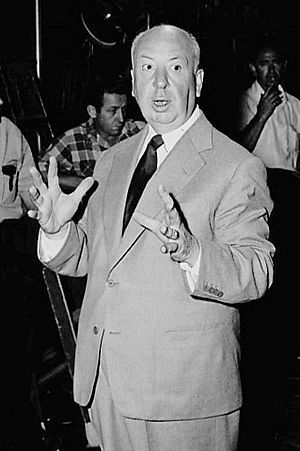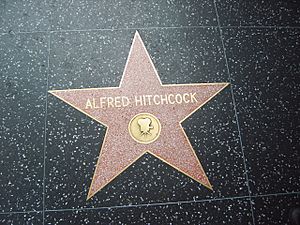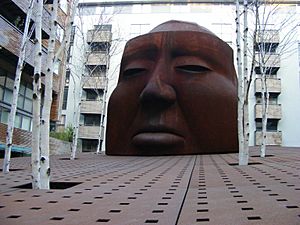Alfred Hitchcock facts for kids
Quick facts for kids
Alfred Hitchcock
|
|
|---|---|

Hitchcock on the set of Alfred Hitchcock Presents in 1955
|
|
| Born |
Alfred Joseph Hitchcock
13 August 1899 Leytonstone, Essex, England
|
| Died | 29 April 1980 (aged 80) Bel Air, California, U.S.
|
| Citizenship | British United States (from 1955) |
| Education | Salesian College, Battersea |
| Alma mater | St Ignatius' College, London |
| Occupation |
|
| Years active | 1919–1980 |
| Spouse(s) |
Alma Reville
(m. 1926) |
| Children | Patricia Hitchcock |
Sir Alfred Joseph Hitchcock (born August 13, 1899 – died April 29, 1980) was a famous English film director and producer. Many people consider him one of the most important filmmakers ever. He was known as "the Master of Suspense" because his movies often made audiences feel very anxious and excited.
Hitchcock directed over 50 feature films during his long career, which lasted six decades. He became as famous as the actors in his movies. This was partly because he gave many interviews, made short appearances (called cameos) in most of his films, and hosted a TV show called Alfred Hitchcock Presents (1955–1965). His films received 46 Oscar nominations and won six awards.
Hitchcock was born in Leytonstone, England. He started working in the film industry in 1919. His first movie as a director was a silent film in 1925. His first big success was The Lodger: A Story of the London Fog (1927). This movie helped create the thriller movie style. In 1929, his film Blackmail was the first British "talkie" (a movie with sound).
Two of his thrillers from the 1930s, The 39 Steps (1935) and The Lady Vanishes (1938), are considered some of the greatest British films of the 20th century. By 1939, Hitchcock was famous around the world. A film producer named David O. Selznick convinced him to move to Hollywood, California. There, he made many more successful movies.
The "Hitchcockian" style of filmmaking often uses special camera movements to show what a character is seeing. He also framed shots in ways that made viewers feel more worried and scared.
By 1960, Hitchcock had directed four films that are often called some of the greatest movies of all time: Rear Window (1954), Vertigo (1958), North by Northwest (1959), and Psycho (1960). In 2012, Vertigo was even named the greatest film ever made by the British Film Institute, based on a worldwide poll of film critics. By 2018, eight of his films were chosen to be saved in the United States National Film Registry because they are so important.
He was married to Alma Reville, who also helped write some of his movies.
Hitchcock received many awards for his work. He got the BAFTA Fellowship in 1971 and the AFI Life Achievement Award in 1979. He was also knighted in December 1979, just four months before he passed away.
Contents
Alfred Hitchcock's Early Life
Alfred Hitchcock was born in a flat above his parents' grocery shop in Leytonstone, which is on the edge of East London. He was the youngest of three children. Hitchcock described himself as a very well-behaved boy. He often told interviewers a story about his father sending him to the police station when he was five. The policeman looked at a note and locked him in a cell for a few minutes, saying, "This is what we do to naughty boys." Hitchcock said this experience made him afraid of policemen for his whole life.
When he was six, his family moved to Limehouse. There, they ran a fish-and-chips shop and a fishmonger's (a shop that sells fish). Hitchcock started school at Howrah House Convent in Poplar in 1907. He also went to other schools, including a convent school and a primary school. For a short time when he was nine, he was a boarder at Salesian College in Battersea.
His family moved again when he was 11, this time to Stepney. On October 5, 1910, Hitchcock started at St Ignatius' College in Stamford Hill, Tottenham. This school was known for its strict rules. He said that this is where he developed his sense of fear.
Hitchcock told his parents he wanted to be an engineer. So, on July 25, 1913, he left St Ignatius and took night classes in engineering. On December 12, 1914, his father died. To support himself and his mother, Hitchcock got a job at the Henley Telegraph and Cable Company in London. He continued his night classes, studying art history, painting, economics, and political science.
Hitchcock was too young to join the army when World War I started in July 1914. When he turned 18 in 1917, he joined a cadet group of the Royal Engineers and practiced drills on weekends.
After the war, Hitchcock started writing creatively. In June 1919, he became an editor and business manager for his company's newspaper, The Henley Telegraph. He wrote several short stories for it. Henley's then moved him to the advertising department, where he wrote ads and drew pictures for electric cables. He loved this job and often stayed late. He also enjoyed watching movies, especially American films by directors like Charlie Chaplin and Fritz Lang.
While still at Henley's, he heard that Famous Players-Lasky (part of Paramount Pictures) was opening a studio in London. He drew some designs for the title cards (text shown between scenes in silent films) for their first movie and sent them to the studio. They hired him, and in 1919, he began working at Islington Studios in Hoxton. Hitchcock gained experience as a co-writer, art director, and production manager on at least 18 silent films.
When Paramount left London in 1922, Hitchcock was hired as an assistant director by a new company called Gainsborough Pictures.
Becoming a Master Filmmaker
Hitchcock's first thriller movie was The Lodger: A Story of the London Fog (1927). It was released in January 1927 and was very successful in the UK. He made his first short appearance (cameo) in this film because an extra actor was needed. He appeared sitting in a newsroom. Hitchcock would briefly appear in most of his own films throughout his career.
Later Years and Legacy
Hitchcock's health declined in the last 20 years of his life, which meant he made fewer movies. Family Plot (1976) was his last completed film. Towards the end of his life, he was working on a spy thriller called The Short Night, but it was never filmed.
Hitchcock was offered a high honor, a CBE, in 1962 but he turned it down. However, he was appointed a Knight Commander of the Most Excellent Order of the British Empire (KBE) in January 1980. He was too ill to travel to London, so the British consul general gave him the award papers at Universal Studios. His last public appearance was on March 16, 1980.
He died from kidney failure the next month, on April 29, at his home in Bel Air. Hitchcock was survived by his wife and daughter. His funeral was held on April 30, and his body was cremated. His ashes were scattered over the Pacific Ocean on May 10, 1980.

Alfred Hitchcock had a huge impact on modern cinema. Many people believe that movies today would be very different without his influence.
He won many awards, including two Golden Globes and five lifetime achievement awards. These included the first BAFTA Academy Fellowship Award and, in 1979, an AFI Life Achievement Award. He was nominated five times for an Academy Award for Best Director. By 2018, eight of his films were chosen to be saved by the US National Film Registry because they are so important.
Hitchcock was given two stars on the Hollywood Walk of Fame on February 8, 1960. One star was for his television work, and the other was for his movies.
Images for kids
-
Hitchcock sculpture at the site of Gainsborough Pictures, Poole Street, Hoxton, north London.
-
The Hitchcocks on their wedding day, Brompton Oratory, December 2, 1926
-
Alma Reville, Joan Harrison, Hitchcock, and Patricia Hitchcock, August 24, 1937
-
Gregory Peck and Ingrid Bergman in Spellbound (1945)
-
James Stewart and Grace Kelly in Rear Window (1954)
-
The Hitchcocks with First Lady Pat Nixon and first daughter Julie Nixon Eisenhower in 1969
-
Kim Novak and James Stewart in Vertigo (1958)
-
Hitchcock at Mount Rushmore filming North by Northwest (1959)
-
An English Heritage blue plaque marks where Hitchcock lived at 153 Cromwell Road, Kensington, London.
-
Hitchcock at work on location in San Francisco.
See also
 In Spanish: Alfred Hitchcock para niños
In Spanish: Alfred Hitchcock para niños





















